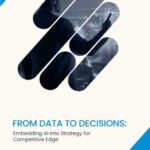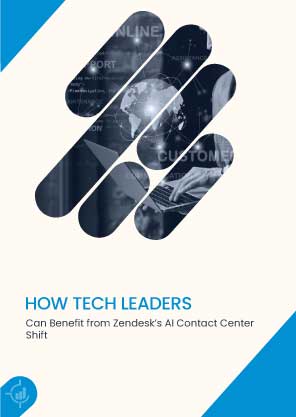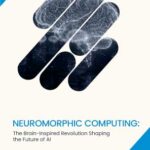or call: +1 (845) 347-8894

or call: +1 (845) 347-8894

“AI is not just another tool—it’s the toolbox.” — Sundar Pichai, CEO, Google.
This quote captures the revolution occurring in B2B lead generation in the entire IT industry. The conventional demand generation tactics – cold emails, manual scoring, and static segmentation no longer work. Decision-makers now anticipate personalized contact, rapid response, and intelligent dialogue from the initial point of contact. That’s where AI in B2B Lead Generation comes into play.
The tech-savvy IT sector is quickly embracing AI to convert intent data into insight and engagement into conversion. This change, though, goes beyond automation; it’s about embedding intelligence within each layer of the funnel. Let’s break down the way AI is transforming lead generation in tech-powered B2B markets.
In conventional B2B models, form-fills or website clicks are generally what marketers use to gauge interest. But AI technology now goes a few steps further by examining behavioral signals across multiple channels like search queries, content consumption, and even social engagement.
With the help of machine learning models, AI platforms have the ability to grade leads not only on activity, but on potential to convert. These predictive scores enable IT marketers to concentrate on leads with the greatest revenue potential.
For instance, an ABM (Account-Based Marketing) platform enabled by AI can recognize changes in a company’s IT team recently researching multi-cloud security and initiate extremely contextualized outreach before the lead completes a single form. This active intelligence removes uncertainty and drastically shortens sales cycles.
Generic messaging and email blasts don’t cut it with technical buyers. They’re information-overloaded and apt to disengage. AI disrupts this paradigm by facilitating hyper-personalization at scale.
Natural Language Processing (NLP) and AI-powered content engines can customize email copy, landing pages, and ad messaging using the buyer’s industry vertical, technographic characteristics, past content engagement, and buying cycle stage.
63% of marketers are already using generative AI in their content strategies, and another 27% plan to adopt it within the next six months.
By pushing CRM information into AI platforms, IT marketers can automatically produce content that speaks to unique pain points. An example is a cloud optimization software company pitching cloud optimization solutions to DevOps leaders, as opposed to CIOs. This sort of context-driven personalization is not feasible without AI. And it can drive conversions directly.
One of the biggest underestimated advantages of AI in B2B Lead Generation is the way it eliminates the lag between action and follow-up. With legacy models, a lead could download a whitepaper and wait hours or days in a queue before being qualified and reached out to.
AI robots and smart workflows now qualify leads in real-time against pre-defined criteria and conversation analysis. Solutions such as Drift and Qualified can interact with visitors based on behavior, ask qualifying questions via chat, and direct sales-ready leads in real-time to SDRs or AEs.
In the technology industry, where purchasing committees are convoluted and sales cycles are lengthy, the pace is a discriminator. AI closes the interval between interest and engagement, enhancing the buying experience and sales results.
The typical B2B tech firm manages staggering volumes of data, CRM history, and webinar registrations, to case study downloads and demo requests. The problem is not gathering data but joining the dots.
AI analytics software combines disconnected data and discovers trends people tend to overlook. To illustrate, AI is able to help discover which content streams drive pipeline establishment, which job functions interact most prior to deal progressions, and which channel delivers the highest ROI for enterprise accounts.
By seeing these insights, AI enables revenue teams and marketers to optimize and double down on campaigns and channels continuously. It is simpler to double down on what is working and shift quickly when something is not. This loop of data-to-insight is key to remaining competitive in the IT market.
Account-based marketing is now a B2B IT sales necessity. But in the absence of AI, it can become manpower-intensive overnight. AI introduces much-needed precision and efficacy into ABM deployment.
AI extends ABM capabilities by distinguishing high-fit accounts by ICP and intent signals, segmenting audiences dynamically on firmographic and technographic changes, personalizing outreach by account stage or departmental function, and scoring engagement across account stakeholders for complete funnel insight.
For instance, if a data infrastructure provider wishes to reach fintech companies that are considering hybrid cloud options, AI can tell them which firms qualify, what they are reading, and who the major influencers are. This allows for stronger alignment between sales and marketing and increased deal velocity.
Marketers have traditionally depended on A/B testing to refine copy, CTAs, and creatives. Conventional A/B testing, however, is usually slow and limiting. AI makes multivariate testing at scale automatic. It can test hundreds of variations across several segments, identify patterns, and redirect budgets to high-performing assets in real time.
This comes in handy, especially in IT-centric campaigns, where various personas, like CISOs and Solutions Architects, react to varied languages, images, and formats. AI does not only tell you what worked. It tells you why it worked and what’s next.
Sales Development Representatives (SDRs) waste an enormous amount of time researching leads, crafting emails, and maintaining CRMs. AI solutions are now automating these mundane tasks, leaving SDRs to concentrate on the conversations that seal the deal.
AI assistants can auto-email sequences from buyer intent, propose follow-up timing from behavior signals, summarize call notes through voice-to-text and sentiment analysis, and auto-populate CRM entries with minimal human intervention.
In IT sales, with products being complex and technical, stakeholders needing customized conversations, this productivity gain is revolutionary. AI doesn’t replace SDRs—it enhances their performance.
One concern is whether AI will make existing marketing systems more complicated. But today’s AI tools are designed to integrate into CRMs, MAPs (such as HubSpot or Marketo), and intent platforms seamlessly. B2B Lead Generation’s AI is most effective when it enhances, rather than replaces, your current stack.
For instance, synchronizing AI-powered lead scores directly into Salesforce, data feeding predictive insights into marketing automation flows, and dynamic content creation within email tools become effortless. Integration is not technical, it’s strategic. IT companies that align AI capabilities across marketing and sales stacks realize quicker time to value.
The use of AI in B2B Lead Generation is not a short-term trend, it’s a long-term transformation. As models become more accurate and generative AI becomes more contextual, we’ll see conversational AI handling deeper technical questions, self-optimizing campaigns with minimal human input, AI forecasting pipeline health and conversion risks, and emotion-aware personalization that adapts in real time.
IT firms that adopt this change now will future-proof their growth plans. But it has to be done with a plan. AI requires good data, well-defined objectives, and human intervention to provide ROI. The objective isn’t automation, but augmentation.
The technology industry is shifting away from lead quantity and towards lead intelligence. AI not only provides leads it also makes you understand, interact, and convert them like never before.
With AI, personalization is accurate, timing is impeccable, targeting is intelligent, and sales alignment is tighter. The effect is evident: acceleration in pipelines, improved conversions, and more predictable revenues. Businesses that incorporate AI into B2B Lead Generation today won’t only create more leads, but they’ll create the right ones.
AI enhances lead quality by analyzing behavioral, intent, and firmographic data in real time. It predicts which prospects are most likely to convert, allowing marketers to focus only on high-fit accounts. This results in better engagement, shorter sales cycles, and increased pipeline efficiency.
Generative AI enables hyper-personalization at scale by crafting tailored emails, landing pages, and ads based on a buyer’s preferences, industry, and stage in the funnel. It reduces manual content creation time and increases relevance, helping IT companies connect meaningfully with technical and executive decision-makers alike.
While AI can automate many aspects of lead gen like scoring, nurturing, and routing, it works best when augmenting human effort. AI handles scale and speed; marketers bring strategy and context. The most effective systems combine automation with human oversight for accuracy and relationship-building.
Common AI tools include predictive analytics platforms, conversational chatbots, generative content engines, AI-powered CRMs, and real-time intent platforms. These tools integrate with existing martech stacks and help IT marketers identify, qualify, and convert leads more efficiently across channels.
Most IT companies adopting AI in lead generation start seeing measurable results, like increased lead quality, faster routing, and higher conversion rates, within three to six months. The key to fast ROI is aligning AI tools with clear goals, clean data, and active campaign monitoring.
To participate in our interviews, please write to our IntentTech Media Room at sudipto@intentamplify.com




